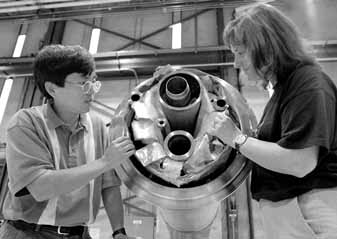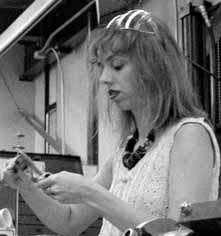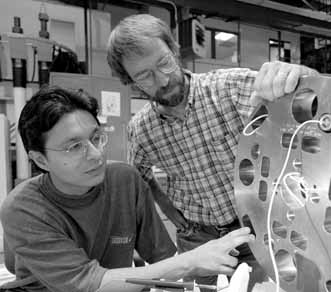 |
|
Engineering the Future by Kurt Riesselmann
When better accelerators are built, engineers will build them.
Great engineering is at the heart of today's most powerful accelerators, and it will have a central role in creating the physics machines of tomorrow.
Jim Kerby and Tom Nichol, mechanical engineers, manage the design and production of the magnets and cryogenic infrastructure. Each magnet is six meters long and forty centimeters in diameter. Electric currents of 12,000 amperes, which flow through superconducting wires, create magnetic field strengths of eight Tesla, one of the highest peak fields ever achieved in the world.
"We are constantly asked to do things that not many people have done before ñ if at all,"Kerby said. "And we are asked to do it fast and cheap."
R&D for superconducting magnets
While Barzi tests and develops the super-conducting wire, Yuri Terechkine works on the fabrication of the coils.
"This new material requires special heat treatment,"Terechkine said. "Afterward, the material is very brittle."
Testing the first Ni3SN magnet will take place next month.
Another group of engineers works on an alternative approach. Instead of pursuing high-field magnet research, it tries to develop an inexpensive type of low-field magnet with field strength of about 2 Tesla.
"Barry Norris and I work on the cooling systems of the initial design,"said Arkadiy Klebaner, a cryogenic engineer. "The magnet cooling scheme is entirely different from the design of the Tevatron and the LHC."
Norris, an electrical engineer, leads a group of 12 people in the Beams Division. About five years ago, his group started work on cooling systems for future accelerators.
"The Technical Division has a lot of people working on magnet designs,"Norris said. "We are the system designers. Any system needs to be automated, instrumented and controlled. And it all needs to be done in a way that fits with existing systems."
Mass production of accelerating structures
Fermilab has joined the research efforts of two other high-energy laboratories, California's SLAC and Japan's KEK, which proposed the use of about 5,000 accelerating structures, each made of 206 copper disks, to build a new high-energy linear electron collider. The shape of the disks must adhere to very stringent design standards to allow the transmission of radiofrequency waves, the electromagnetic fields that accelerate the electrons.
Assuring the quality of disks is one of Arkan's biggest concerns.
"Mechanical quality control systems rely on touching the disks, and that puts dents in them," he said. "Optical systems are much better, but they can only measure flat surfaces. We built a radiofrequency test stand that can check whether each disk has the correct 11.4 gigahertz resonance frequency."
Cutting the production cost is another concern. At Fermilab, Arkan and coworkers are setting up an R&D factory for the production of RF prototype structures.
"We try to industrialize the project,"he explained. "At present, the RF structures are expensive to make, and they push technology to the extreme. We want to develop a production process that is capable of producing one million disks in three years with the least amount of scrap. [Because of the tight tolerances] we must use robotic systems. We cannot put human interaction into the game."
Building collider facilities
For a linear collider with one million RF disks, scientists need a straight tunnel about 30 kilometers long. Working with the physicists of the project, engineers are investigating where and how such a tunnel could be built. The tunnel location is especially important.
"A linear collider is very sensitive to ground motion,"explained Jeff Sims, a civil engineer who has worked on the layout of three different accelerators. "We try to understand very precisely how rock responds to cultural noise, like traffic on highways at the surface."
Finding the right solution is an iterative and innovative process, an aspect that Sims enjoys.
"There is a lot of brainstorming involved in projects at this level,"said Sims. "The FESS engineering group acts as an in-house engineering consulting firm to the physicists. It is a fun group to work with."
Given the physicists' needs for new colliders, the fun will continue.
More on the web: |
| last modified 3/16/2001 by C. Hebert email Fermilab |
FRLsDFx9eyfrPXgV


 "The current design requires the disk surface to be flat within one micron,"said Tug Arkan, who engineers the production process. "The surface is so flat and shiny that nobody is allowed to touch it."
"The current design requires the disk surface to be flat within one micron,"said Tug Arkan, who engineers the production process. "The surface is so flat and shiny that nobody is allowed to touch it."